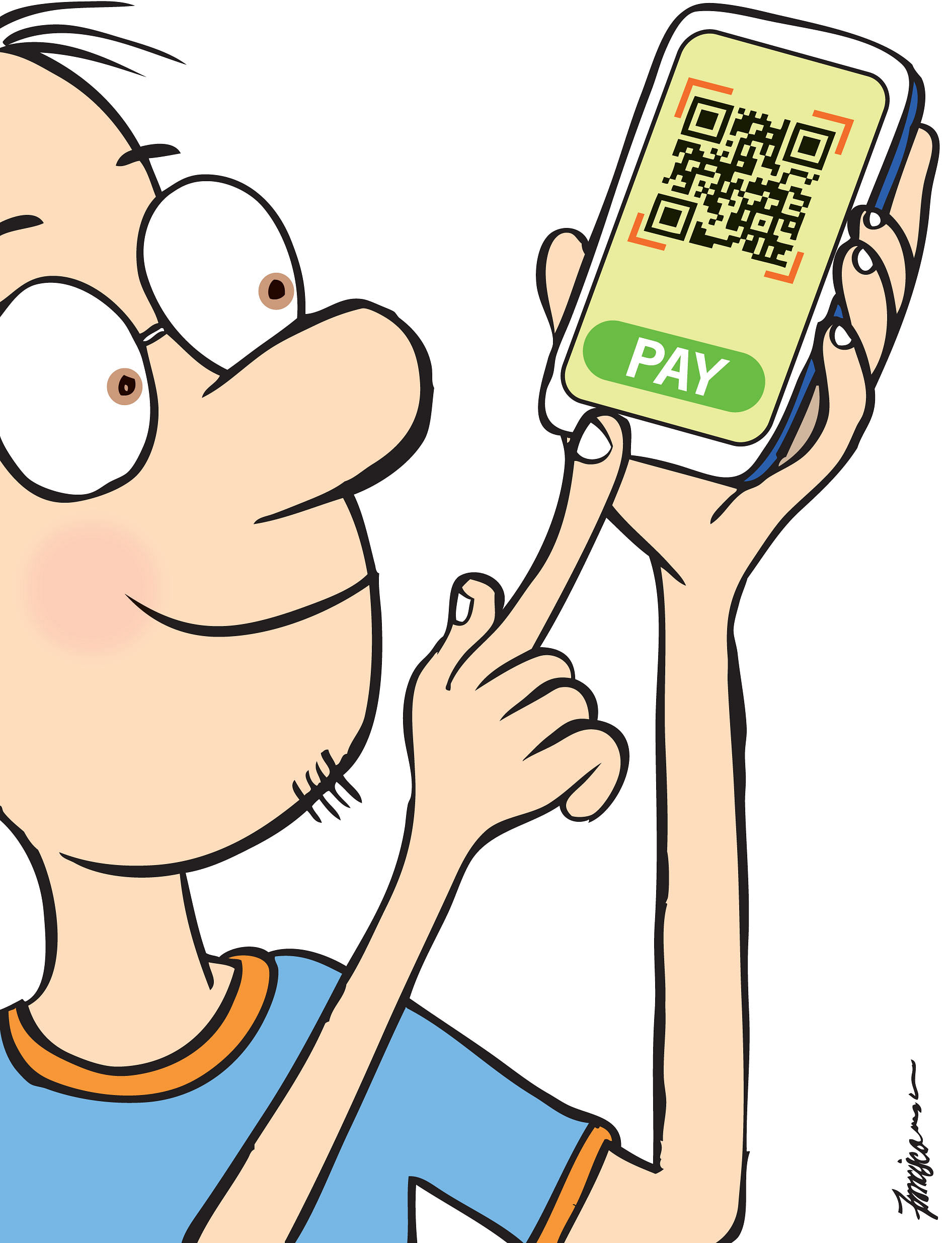Three moves have been announced that will, for example, make ordering a plate of chicken rice at your favourite hawker centre a breeze, without jiggling coins and handling food-stained dollar notes.
First, one firm has been appointed to bring a wide range of electronic-payment solutions to hawkers - the last segment of the retail sector here where cash is still king - so that diners can choose to pay from their preferred e-wallet.
A universal QR (quick response) code will be rolled out from this month to streamline cashless processes over the counter across the nation. So diners need to scan only one QR code with their smartphones to pay for a cup of Toast Box coffee or a bowl of wonton mee from the nearby coffee shop.
And Singapore's central instant funds transfer network - currently open only to banks - will soon accept non-banks such as Grab so consumers can cash out from any e-wallet any time, or transfer the value across e-wallets.
These three recent moves, with accompanying policy changes, are said to be the final building blocks of a ubiquitous, easy-to-use cashless system that Singapore desires.
At the launch of Singapore's national QR code - dubbed SGQR - on Monday, Monetary Authority of Singapore (MAS) board member Ong Ye Kung, who is also Education Minister, said: "These may well be the last few jigsaw pieces we are putting in place to complete the national e-payment infrastructure."
How close is Singapore to putting together the jigsaw puzzle now, with the three moves and heavier government involvement?
HAWKERS' NEED
Last week's appointment of Singapore's oldest e-payment firm, Nets, to bring a universal cashless system that accepts all kinds of payment methods to all 12,000 stalls at hawker centres, industrial canteens and coffee shops will add momentum to the nation's cashless push.

Enterprise Singapore, the National Environment Agency and the Housing Board zeroed in on hawkers managed by public agencies as they have greater control over them.
Hawkers are the last segment of the retail scene here where cash is still king. Some 70 per cent of hawker transactions are done using cash, according to the MAS. Conversely, 70 per cent of transactions at malls, restaurants and eateries are already cashless.
It is also a segment that cannot be ignored, as a whopping 40 per cent of dining occasions take place at coffee shops, hawker centres and canteens.
The hawker initiative came on the heels of Prime Minister Lee Hsien Loong's call in his National Day Rally speech last year to "simplify and integrate" the range of solutions that littered payment counters.
For years, the Government has resisted stepping in to unite payment systems, citing its preference for the private sector to take the lead.
But letting commercial entities divide and conquer for decades has given rise to the problem of merchants accepting one payment option and not another, confusing consumers as a result.
Consider the two most widely used cards, ez-link and CashCard: The former does not work at some carpark gantries, though it is accepted for public transport payments. So motorists still need their CashCards.
E-wallets such as Singtel Dash, GrabPay, DBS PayLah, OCBC Pay AnyOne, UOB Mighty and NetsPay entered the fray over the past four years, adding to consumers' confusion.
PM Lee's call last year changed the status quo, and for the better.
MAJOR OBSTACLES REMOVED
By appointing Nets as the single touchpoint, the Government has addressed most of the roadblocks cited by hawkers in switching to cashless payments.
A major obstacle is the hassle of dealing with multiple parties to accept a variety of payment methods.
For instance, bills are itemised and described differently, and the day's account may not be settled at the same time. This translates to complicated account reconciliation.
Little wonder, then, that hawkers prefer cash. And even those who have gone cashless rarely accept more than two e-payment options.
Enter Nets, the single touchpoint for 20 payment methods, including e-wallets such as Singtel Dash and GrabPay, transport cards such as ez-link and Nets FlashPay, and Visa and Mastercard credit cards.
There will be only one accounting style: that of Nets. And settlement is standardised, being completed in one or two business days.
Also, with 20 schemes folded into Nets' master offerings, there is a much higher chance that consumers' preferred e-wallet or payment card would be accepted by hawkers.
By all accounts, there is no better time to jump on the cashless bandwagon than now. This is chiefly because the Government is picking up the tab for equipment rental and the 0.5 per cent transaction fee for three years upon hawkers signing up with Nets.
Stalls have until August 2020 to apply for the fee waivers.
INSTANT GRATIFICATION
However, cash flow concerns are not fully addressed.
Payments to hawkers will still be settled a day later for most of the payment schemes. Transactions made via American Express, Mastercard and Visa will be credited in two business days.
Here is where the second move, the roll-out of SGQR, comes in handy.
As PayNow is one of the 27 accepted payment modes, merchants will get payments into their bank accounts instantly.
First launched in July last year, PayNow is an instant funds transfer service linked to people's mobile phone numbers or NRIC numbers. Senders need not enter any bank account numbers to transfer funds.
When hawkers register their business UEN (Unique Entity Number) with PayNow Corporate, they can receive instant funds from all PayNow users. There are 1.2 million such users now - and counting.
Payment is done by diners scanning the SGQR sticker, which will be issued from later this month.
PayNow will be activated on SGQR in the coming months, after which, paying for a plate of chicken rice can be done instantly by scanning the sticker - almost like using cash, as the transfer will be instant.
CONFUSION MAY PERSIST
SGQR has another purpose, however, which is unlikely to move the needle.
It is meant to "neaten" the payment counters of merchants in malls, which already have some form of cashless system installed. With the universal SGQR, they do not need to have what can be a cluttered and confusing display of other QR codes, in order to accept multiple payment modes.
All well and good, but there is no government subsidy to streamline account reconciliation for merchants in malls, which are mostly run by private-sector landlords - so it is pretty much status quo in terms of payment settlement relationships.
Consumers should also not be surprised if they are turned down by a mall merchant while using e-wallet A when the merchant accepts only e-wallet B.
Merchants rarely accept more than three e-payment methods, even if the code on the displayed SGQR sticker is theoretically compatible with 27 payment modes.
This point is voiced by Toast Box's regional general manager, Mr Vincent Lim. He said that working with all the players would mean more work in reconciling accounts at the end of the business day.
"We work with only the bigger players as they would have accounted for most of the consumers out there," said Mr Lim.
At this point, consumers may still be confused as almost every e-wallet would be accepted at hawker centres, but their preferred payment mode may be denied at malls.
COMPATIBILITY ISSUES
The scenario of merchants rejecting one e-wallet over another is not expected to change, even after Singapore opens up its central banking instant funds transfer network to non-banks.
This network is called Fast. It was launched in 2014 to power instant funds transfers across banks.
Fast hit mainstream use with the launch of PayNow in July last year. To date, it has processed more than $1.5 billion worth of transfers.
The biggest benefit of opening up Fast to non-banks will be seen when one needs to move funds from one e-payment app to another, or when one needs to cash out the value.
MAS will be forming an industry working group to iron out technical details and address any concerns from banks before opening up Fast.
Until then, consumers will still be dealing with stored value "stuck" in certain e-wallets without the option of cashing out or transferring the value to another e-wallet.
This problem has to be addressed fast to encourage people to download and use e-wallets. All will come to nought if hawkers and merchants have the technology in place but no customer uses it.
People, especially the elderly, also need to be comfortable with cashless means amid rising scams. This could be the last remaining jigsaw piece that the Singapore Government needs to find and add to complete the puzzle.

